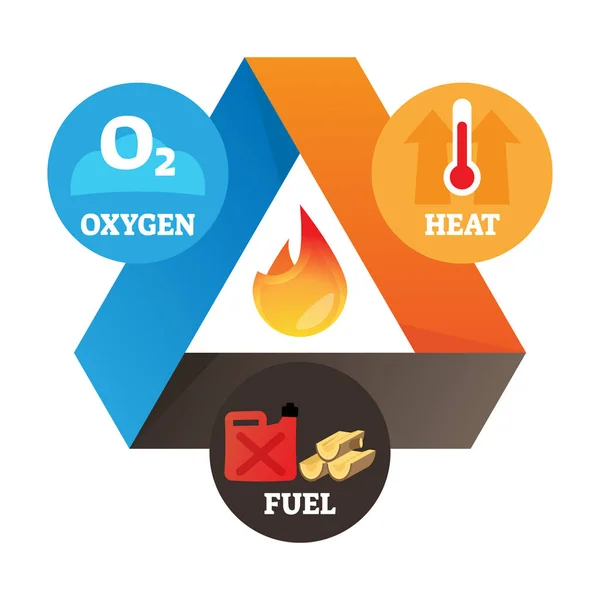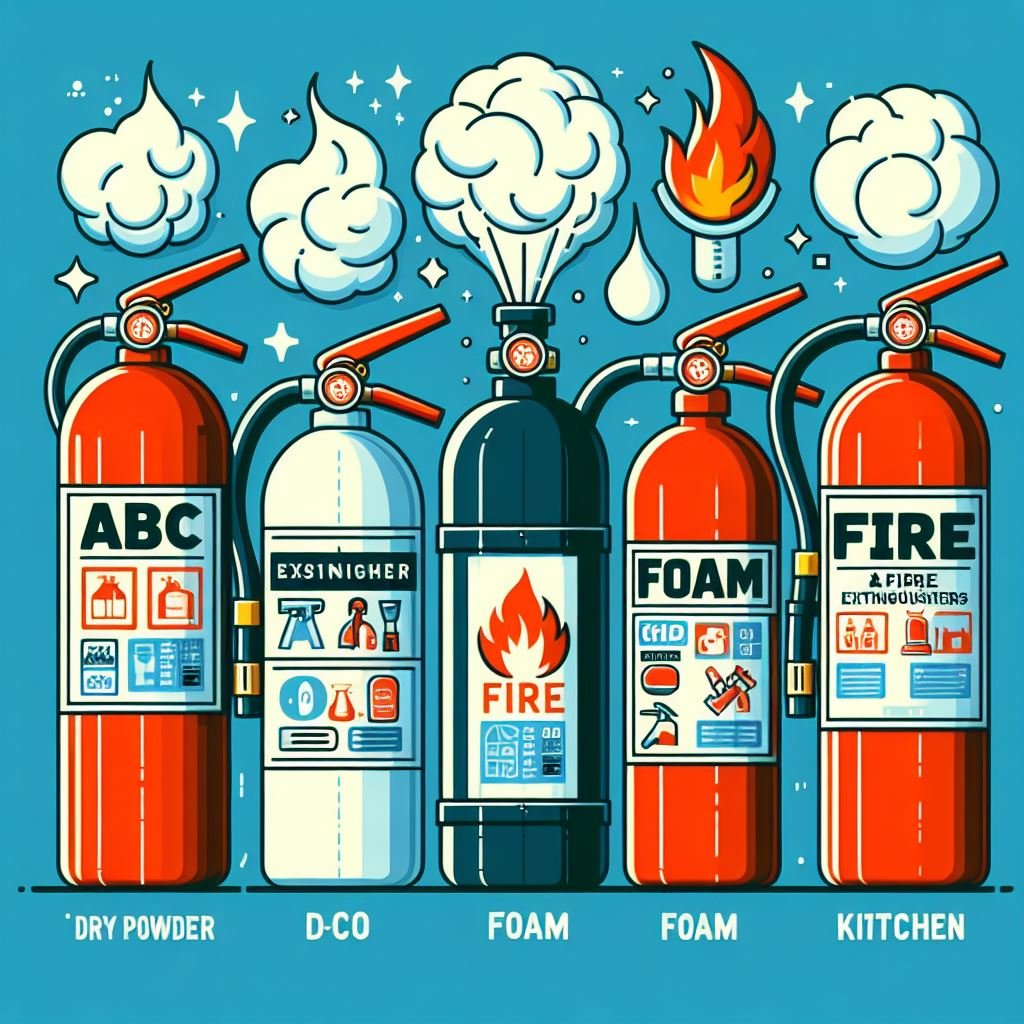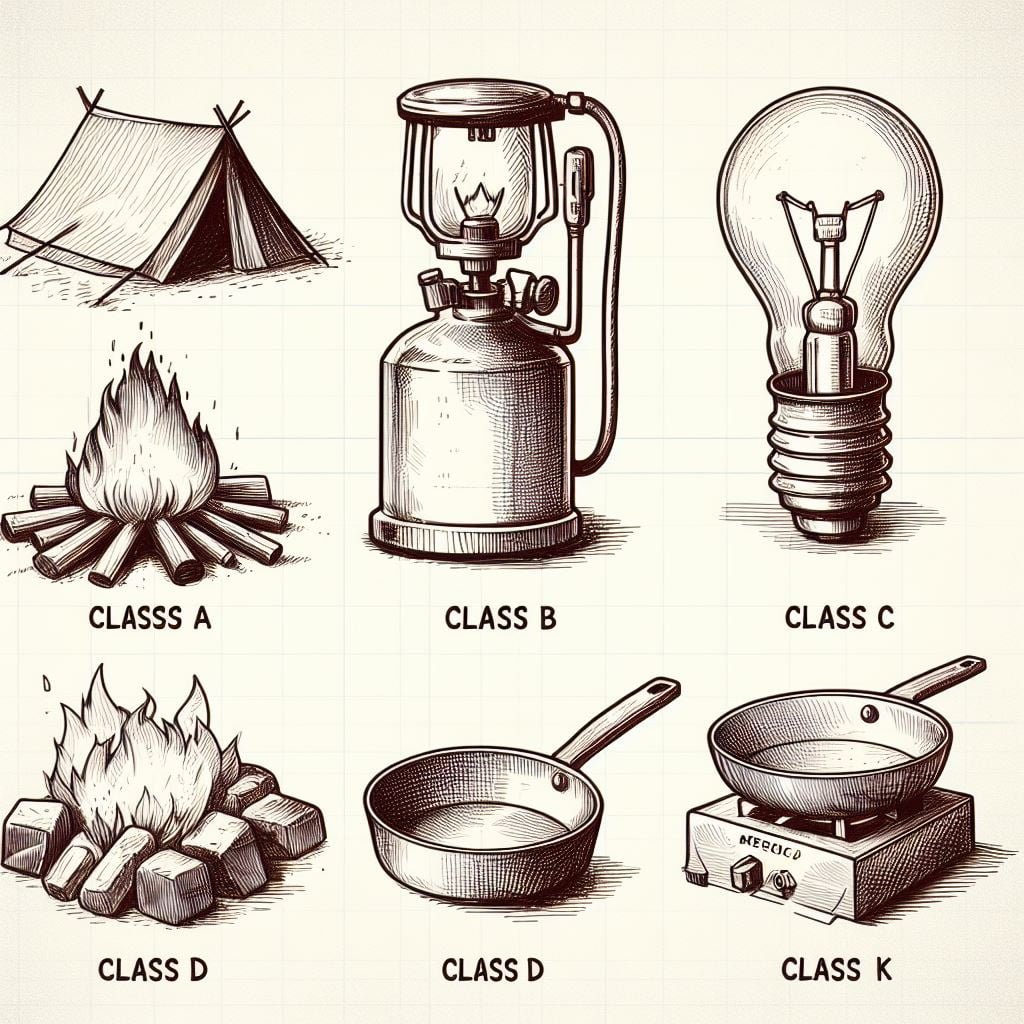What are Different Types of Fire? Ultimate Guide
What is Fire? : Exploring Fire Chemistry
You might think of fire as just something that burns, but there’s a whole science behind it! Let’s dive into the fascinating world of fire chemistry together.
The Fire Triangle: Fuel, Oxygen, and Heat
A triangle with three sides – fuel, oxygen, and heat. These are the three key ingredients needed to start and sustain a fire. Think of fuel as the food for the fire, oxygen as its breath, and heat as the spark that ignites the whole thing. Without one of these elements, the fire triangle collapses, and the flames fizzle out. Every types of Fire has the same triangle as below

Types of Fire: What’s Cooking?
Not all fires are created equal. In fact, there are several distinct types, each with its own unique characteristics. Understanding these differences is crucial for knowing how to tackle them effectively. Let’s break it down:
1. Class A Fires: Combustibles Galore
Class A fires involve ordinary combustible materials like wood, paper, cloth, and plastic. These are the kinds of fires you might encounter in your everyday life, whether it’s a kitchen mishap or a stray spark igniting dry leaves in your backyard. Water and dry chemical extinguishers are your go-to weapons against these fiery foes.
2. Class B Fires: Flammable Liquids
Got grease in the pan or spilled gasoline in the garage? That’s Class B territory. These fires involve flammable liquids and gases like gasoline, oil, propane, and alcohol. Traditional water extinguishers won’t cut it here – you’ll need something like foam or CO2 to smother the flames and starve them of oxygen.
3. Class C Fires: Electrical Hazards
Class C fires pose a unique challenge because they involve energized electrical equipment. Think overloaded outlets, faulty wiring, or malfunctioning appliances. Using water-based extinguishers on these fires can be downright dangerous, as they can conduct electricity and put you at risk of shock. Instead, opt for a non-conductive agent like dry chemical or CO2 to snuff out the flames safely.
Key Takeaway
Remember these important insights as you continue reading.
4. Class D Fires: Metal Mayhem
When it comes to Class D fires, we’re talking about metals – specifically, combustible metals like magnesium, titanium, and sodium. These fires are rare but extremely hazardous, often occurring in industrial settings where these metals are being used or processed. Water is a big no-no here, as it can actually make the fire worse by reacting violently with the metal. Instead, specialized dry powder extinguishers are the way to go.
5. Class K Fires: Kitchen Carnage
Last but not least, we have Class K fires, also known as kitchen fires. These are a subset of Class B fires but deserve their own category due to the unique challenges they present. Class K fires involve cooking oils and fats, which can ignite at high temperatures and spread rapidly. Traditional extinguishers may not be effective against these stubborn flames, so specialized wet chemical extinguishers are recommended for kitchen use.
You can learn more about Types of Fire here.

The Chemistry Behind the Flames: Breaking It Down
Now that we know the basics, let’s zoom in on what really happens when things catch fire. It’s all about a fancy process called combustion, which is basically a super quick chemical reaction between fuel and oxygen.
When you light a match or use a lighter, you’re starting this reaction by giving it some heat. As the fuel gets hotter, its tiny parts get all jumpy until they break apart and mix with the oxygen in the air.
This mix-up of tiny parts gives off energy as heat and light, which we see as flames. It’s like a mini explosion right in front of us! And guess what? It’s all because of the cool science of chemistry.
Wrapping Up: Knowledge is Power
So there you have it – a crash course in the chemistry behind various fire types. Armed with this newfound knowledge, you’ll be better equipped to face any fiery situation that comes your way. Just remember the golden rule of fire safety: always respect the flames, and never underestimate their power. Stay safe out there! Each types of Fire has different types of safety measures.
Key Takeaway
Remember these important insights as you continue reading.
Spotting Fire Hazards: Your Handy Guide
Hi there, expert in fire safety! Have you ever pondered how to identify possible fire threats before they become a full-fledged conflagration? Now, you can stop wondering! With our inside knowledge, you can quickly transform your day from fiery to smoldering by spotting those cunning offenders.
1. Know Your Enemy: Common Fire Hazards
First things first, let’s talk about the usual suspects. From the clutter in your garage to the lint in your dryer, fire hazards come in all shapes and sizes. Keep an eye out for:
- ✓ Overloaded power outlets and extension cords
- ✓ Faulty wiring or electrical appliances
- ✓ Flammable liquids like gasoline and paint thinners
- ✓ Combustible materials such as paper, cardboard, and fabrics
- ✓ Unattended candles or smoking materials
- ✓ Grease buildup in the kitchen or barbecue area
By familiarizing yourself with these potential troublemakers, you’ll be better equipped to nip them in the bud before they spark trouble.
2. Eyes Wide Open: Stay Vigilant
Alright, let’s talk about the usual suspects when it comes to fire risks. They come in all shapes and sizes, from stuff lying around your garage to the fluff in your dryer. Keep an eye out for:
- ✓ Things that can easily catch fire, like paint thinner and gasoline
- ✓ Faulty wires or electrical gadgets
- ✓ Too many things plugged into one socket
- ✓ Stuff like clothes, cardboard, and paper that can burn easily
- ✓ Leaving candles or cigarettes burning without supervision
- ✓ Grease building up in the kitchen when you cook If you know about these troublemakers, you can stop them before they cause any problems.
Remember, a little vigilance goes a long way when it comes to fire safety. So, keep those peepers peeled!
3. Trust Your Nose: Sniff Out Trouble
It may surprise you to realise that your sense of smell may be an effective tool for detecting potential fire dangers. Some odours may be early warning signs of approaching peril. If you smell any of the following odours, you should investigate further:
Key Takeaway
Remember these important insights as you continue reading.
A strong chemical scent near flammable substances or cleaning supplies; a burning or electrical odour near appliances or outlets; A gas odour around stoves, water heaters, or furnaces; a musty or smokey odour coming from the attic or crawlspace
The signals originating from your nose should not be disregarded; they might be trying to tell you something important!
Safety First, Always: Final Words
There you have it, folks – your crash course in spotting fire hazards like a pro! By staying informed, staying vigilant, and trusting your instincts, you can keep yourself and your loved ones safe from the threat of fire. Remember, when it comes to fire safety, there’s no such thing as being too careful. So, keep your eyes peeled, your nose keen, and your surroundings tidy. Here’s to a fire-free future!
How to select Fire Extinguisher on the basis of Types of Fire. Click Here
Unlocking the Code: Creative Ways to Remember Fire Classifications
Hey there, fellow fire safety enthusiast! Ever found yourself scratching your head trying to remember the different fire classifications? Fear not, because we’ve got some nifty tricks up our sleeves to help you nail those classifications like a pro.
1. Mnemonics Made Fun
Let’s kick things off with everyone’s favourite memory hack: mnemonics! These handy little tricks use acronyms or phrases to help you remember complex information. Here are a few fire classification mnemonics to tickle your fancy:
- ✓ “Always Be Cool” – Remember Class A, which involves ordinary combustibles like wood and paper.
- ✓ “Better Bring Foam” – Recall Class B fires, which deal with flammable liquids like gasoline and oil.
- ✓ “Call Electricians” – Jog your memory about Class C fires, which involve electrical equipment.
- ✓ “Don’t Drop Metal” – Keep Class D fires in mind, which are all about combustible metals like magnesium and titanium.
- ✓ “Kitchen Chaos” – Associate Class K fires with the chaos of the kitchen, where cooking oils and fats can ignite.
With these catchy phrases in your arsenal, you’ll never forget your fire classifications again!
Key Takeaway
Remember these important insights as you continue reading.
2. Visual Aids: Picture This!
They say a picture is worth a thousand words, and when it comes to remembering fire classifications, truer words were never spoken!
By engaging your visual memory, you’ll have those fire classifications locked down in no time!

3. Storytime: Make It Memorable
Who doesn’t love a good story? Why not create a narrative that incorporates each fire classification into a memorable tale? Here’s an example to get your creative juices flowing:
Once upon a time, in a cozy cabin in the woods (Class A), a clumsy chef spilled oil all over the kitchen floor (Class B). Panicked, they reached for the toaster to call for help (Class C), only to realize it was short-circuiting! Meanwhile, in the nearby factory, a metalworker accidentally dropped a magnesium ingot (Class D), causing a blazing inferno. And in the bustling restaurant kitchen, a chef’s flaming skillet of grease (Class K) threatened to turn the whole place into a fiery feast!
By weaving the fire classifications into a story, you’ll not only entertain yourself but also solidify your understanding of each class.
In Conclusion: Fire Classifications, Unforgettable Edition
And there you have it, folks – a whirlwind tour of creative ways to remember fire classifications! Whether you’re a visual learner, a storyteller at heart, or a fan of catchy mnemonics, there’s a memory trick out there just waiting for you to discover it.
So, the next time someone asks you about Class A, B, C, D, or K fires, you can confidently respond with a smile on your face and a spark of creativity in your mind. Remember, when it comes to fire safety, knowledge is power – and a little creativity goes a long way!
Choosing the Right Extinguisher: A Fire Safety Must-Have
Hey there, fire safety enthusiasts! Let’s talk about why it’s crucial to choose the right extinguisher for the job. Trust us, it’s not just about grabbing the closest one and hoping for the best. Here’s why:
Key Takeaway
Remember these important insights as you continue reading.
1. Putting Out the Right Fire: Class Matters
Picture this: you’re faced with a flaming grease fire in the kitchen, but all you have is a water extinguisher. Uh-oh! Choosing the correct extinguisher based on the type of fire is essential. Here’s a quick breakdown:
- ✓ Class A: Ordinary combustibles like wood and paper
- ✓ Class B: Flammable liquids like gasoline and oil
- ✓ Class C: Electrical fires involving appliances or wiring
- ✓ Class D: Combustible metals like magnesium and titanium
- ✓ Class K: Kitchen fires involving cooking oils and fats
Using the wrong extinguisher can actually make the fire worse, so be sure to match the class to the fire.
2. Efficiency Is Key: Don’t Waste Time
Imagine trying to put out a roaring inferno with a tiny handheld extinguisher. Not exactly effective, right? Choosing the right size and type of extinguisher ensures that you can tackle the fire quickly and efficiently. After all, every second counts in an emergency!
- ✓ Keep larger extinguishers in high-risk areas like kitchens and workshops.
- ✓ Make sure everyone knows where the extinguishers are located for easy access.
- ✓ Regularly check the pressure gauge to ensure the extinguisher is ready for action.
By having the right extinguisher on hand, you can nip potential fires in the bud before they have a chance to spread.
3. Safety First: Protect Yourself and Others
Last but not least, choosing the right extinguisher isn’t just about putting out fires – it’s also about keeping yourself and others safe in the process. Using the wrong extinguisher can put you at risk of injury or even exacerbate the fire. Here are a few safety tips to keep in mind:
- ✓ Stand back from the fire and aim the extinguisher at the base of the flames.
- ✓ Use a sweeping motion to evenly distribute the extinguishing agent.
- ✓ If the fire doesn’t respond to your initial efforts, evacuate the area immediately and call for help.
- ✓ Never attempt to fight a fire if it’s spreading rapidly or if you’re unsure of the type of extinguisher to use.
Remember, your safety is paramount, so don’t take unnecessary risks when it comes to fire extinguisher selection.
Key Takeaway
Remember these important insights as you continue reading.
In Conclusion: Choose Wisely, Stay Safe
So there you have it, folks – the importance of choosing the right extinguisher in a nutshell. By selecting the appropriate extinguisher based on the type of fire, ensuring it’s the right size and readily accessible, and prioritizing safety above all else, you can protect yourself and others from the dangers of fire.
So, the next time you’re faced with a fire emergency, don’t just grab any old extinguisher – choose wisely and stay safe out there!
Pingback: Fire Extinguishing Agents - Types & Its Properties
Pingback: Fire Fighting System - Types of Valves
Pingback: Fire Safety in schools with Indian Government Guidelines
Pingback: Fire Extinguisher placement requirements: General Guide